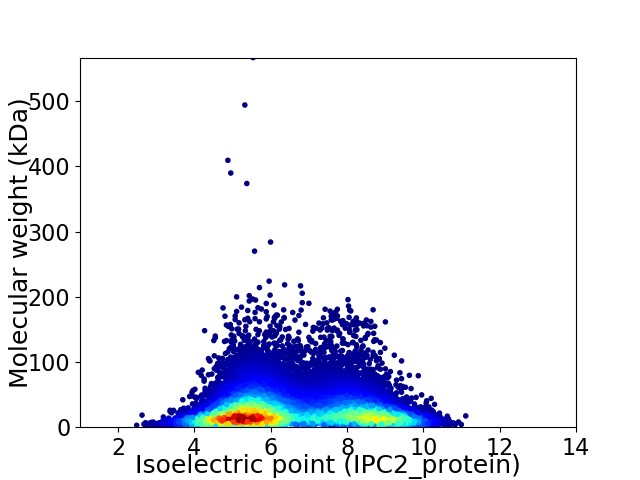
Trifolium pratense (Red clover)
Taxonomy: cellular organisms; Eukaryota; Viridiplantae; Streptophyta; Streptophytina; Embryophyta; Tracheophyta; Euphyllophyta; Spermatophyta; Magnoliopsida; Mesangiospermae; eudicotyledons; Gunneridae; Pentapetalae; rosids; fabids; Fabales; Fabaceae; Papilionoideae; 50 kb inversion clade; NPAAA clade;
Average proteome isoelectric point is 6.56
Get precalculated fractions of proteins

Virtual 2D-PAGE plot for 60146 proteins (isoelectric point calculated using IPC2_protein)
Get csv file with sequences according to given criteria:
* You can choose from 21 different methods for calculating isoelectric point
Summary statistics related to proteome-wise predictions



Protein with the lowest isoelectric point:
>tr|A0A2K3KGK8|A0A2K3KGK8_TRIPR Uncharacterized protein OS=Trifolium pratense OX=57577 GN=L195_g054530 PE=4 SV=1
EEE2 pKa = 4.88HH3 pKa = 6.92SDDD6 pKa = 5.5FTLDDD11 pKa = 3.73ILSDDD16 pKa = 4.59DD17 pKa = 4.23AEEE20 pKa = 4.38PAPDDD25 pKa = 3.31SPPNDDD31 pKa = 3.78VEEE34 pKa = 4.42PAPHHH39 pKa = 6.98HH40 pKa = 6.61PPDDD44 pKa = 3.76DD45 pKa = 3.77AEEE48 pKa = 4.24PAPYYY53 pKa = 9.91HH54 pKa = 6.36PPDDD58 pKa = 4.41DD59 pKa = 4.02AEEE62 pKa = 4.13PAPYYY67 pKa = 9.72HH68 pKa = 6.75PPDDD72 pKa = 3.94DD73 pKa = 3.66AEEE76 pKa = 4.21PTPHHH81 pKa = 7.01HH82 pKa = 6.13HHH84 pKa = 7.29DDD86 pKa = 3.45DD87 pKa = 4.47AEEE90 pKa = 4.16PAPAISPSDDD100 pKa = 3.52
EEE2 pKa = 4.88HH3 pKa = 6.92SDDD6 pKa = 5.5FTLDDD11 pKa = 3.73ILSDDD16 pKa = 4.59DD17 pKa = 4.23AEEE20 pKa = 4.38PAPDDD25 pKa = 3.31SPPNDDD31 pKa = 3.78VEEE34 pKa = 4.42PAPHHH39 pKa = 6.98HH40 pKa = 6.61PPDDD44 pKa = 3.76DD45 pKa = 3.77AEEE48 pKa = 4.24PAPYYY53 pKa = 9.91HH54 pKa = 6.36PPDDD58 pKa = 4.41DD59 pKa = 4.02AEEE62 pKa = 4.13PAPYYY67 pKa = 9.72HH68 pKa = 6.75PPDDD72 pKa = 3.94DD73 pKa = 3.66AEEE76 pKa = 4.21PTPHHH81 pKa = 7.01HH82 pKa = 6.13HHH84 pKa = 7.29DDD86 pKa = 3.45DD87 pKa = 4.47AEEE90 pKa = 4.16PAPAISPSDDD100 pKa = 3.52
Molecular weight: 10.38 kDa
Isoelectric point according different methods:
Protein with the highest isoelectric point:
>tr|A0A2K3JVU4|A0A2K3JVU4_TRIPR Uncharacterized protein (Fragment) OS=Trifolium pratense OX=57577 GN=L195_g059059 PE=4 SV=1
MM1 pKa = 7.25TRR3 pKa = 11.84PNHH6 pKa = 4.84HH7 pKa = 6.72HH8 pKa = 7.39RR9 pKa = 11.84ITVLLMTRR17 pKa = 11.84PNHH20 pKa = 5.7LLRR23 pKa = 11.84IKK25 pKa = 10.11VLLMTRR31 pKa = 11.84VNHH34 pKa = 6.53LLRR37 pKa = 11.84ITVLPMTQPSHH48 pKa = 4.46QHH50 pKa = 6.58RR51 pKa = 11.84ITILLMTRR59 pKa = 11.84PNHH62 pKa = 6.07LPHH65 pKa = 6.21ITVLLMTRR73 pKa = 11.84LNHH76 pKa = 5.48LHH78 pKa = 7.43RR79 pKa = 11.84ITVIPMTRR87 pKa = 11.84QNRR90 pKa = 11.84QHH92 pKa = 6.03QPSALLMNLLSNMQPNN108 pKa = 3.46
MM1 pKa = 7.25TRR3 pKa = 11.84PNHH6 pKa = 4.84HH7 pKa = 6.72HH8 pKa = 7.39RR9 pKa = 11.84ITVLLMTRR17 pKa = 11.84PNHH20 pKa = 5.7LLRR23 pKa = 11.84IKK25 pKa = 10.11VLLMTRR31 pKa = 11.84VNHH34 pKa = 6.53LLRR37 pKa = 11.84ITVLPMTQPSHH48 pKa = 4.46QHH50 pKa = 6.58RR51 pKa = 11.84ITILLMTRR59 pKa = 11.84PNHH62 pKa = 6.07LPHH65 pKa = 6.21ITVLLMTRR73 pKa = 11.84LNHH76 pKa = 5.48LHH78 pKa = 7.43RR79 pKa = 11.84ITVIPMTRR87 pKa = 11.84QNRR90 pKa = 11.84QHH92 pKa = 6.03QPSALLMNLLSNMQPNN108 pKa = 3.46
Molecular weight: 12.83 kDa
Isoelectric point according different methods:
Peptides (in silico digests for buttom-up proteomics)
Below you can find in silico digests of the whole proteome with Trypsin, Chymotrypsin, Trypsin+LysC, LysN, ArgC proteases suitable for different mass spec machines.| Try ESI |
 |
|---|
| ChTry ESI |
 |
|---|
| ArgC ESI |
 |
|---|
| LysN ESI |
 |
|---|
| TryLysC ESI |
 |
|---|
| Try MALDI |
 |
|---|
| ChTry MALDI |
 |
|---|
| ArgC MALDI |
 |
|---|
| LysN MALDI |
 |
|---|
| TryLysC MALDI |
 |
|---|
| Try LTQ |
 |
|---|
| ChTry LTQ |
 |
|---|
| ArgC LTQ |
 |
|---|
| LysN LTQ |
 |
|---|
| TryLysC LTQ |
 |
|---|
| Try MSlow |
 |
|---|
| ChTry MSlow |
 |
|---|
| ArgC MSlow |
 |
|---|
| LysN MSlow |
 |
|---|
| TryLysC MSlow |
 |
|---|
| Try MShigh |
 |
|---|
| ChTry MShigh |
 |
|---|
| ArgC MShigh |
 |
|---|
| LysN MShigh |
 |
|---|
| TryLysC MShigh |
 |
|---|
General Statistics
Number of major isoforms |
Number of additional isoforms |
Number of all proteins |
Number of amino acids |
Min. Seq. Length |
Max. Seq. Length |
Avg. Seq. Length |
Avg. Mol. Weight |
|---|---|---|---|---|---|---|---|
15246222 |
9 |
5096 |
253.5 |
28.4 |
Amino acid frequency
Ala |
Cys |
Asp |
Glu |
Phe |
Gly |
His |
Ile |
Lys |
Leu |
|---|---|---|---|---|---|---|---|---|---|
6.2 ± 0.01 | 1.851 ± 0.005 |
5.511 ± 0.008 | 6.516 ± 0.013 |
4.232 ± 0.007 | 6.306 ± 0.012 |
2.452 ± 0.005 | 5.626 ± 0.007 |
6.458 ± 0.013 | 9.496 ± 0.014 |
Met |
Asn |
Gln |
Pro |
Arg |
Ser |
Thr |
Val |
Trp |
Tyr |
|---|---|---|---|---|---|---|---|---|---|
2.455 ± 0.006 | 4.95 ± 0.008 |
4.705 ± 0.012 | 3.677 ± 0.008 |
4.964 ± 0.009 | 8.689 ± 0.013 |
5.04 ± 0.008 | 6.66 ± 0.009 |
1.361 ± 0.005 | 2.818 ± 0.006 |
Most of the basic statistics you can see at this page can be downloaded from this CSV file
Proteome-pI is available under Creative Commons Attribution-NoDerivs license, for more details see here
| Reference: Kozlowski LP. Proteome-pI 2.0: Proteome Isoelectric Point Database Update. Nucleic Acids Res. 2021, doi: 10.1093/nar/gkab944 | Contact: Lukasz P. Kozlowski |
